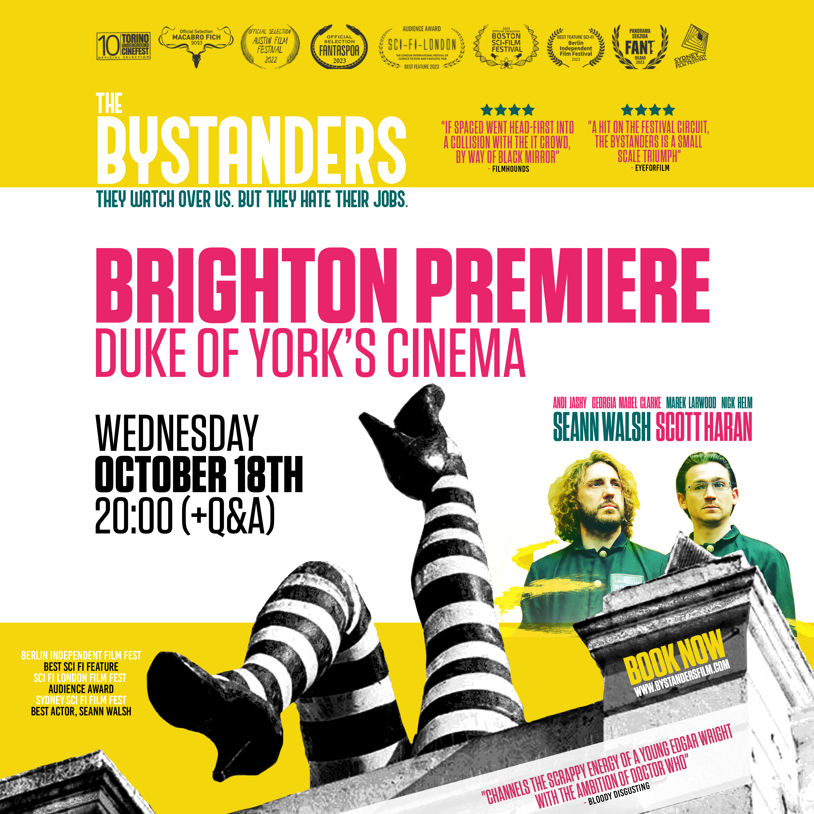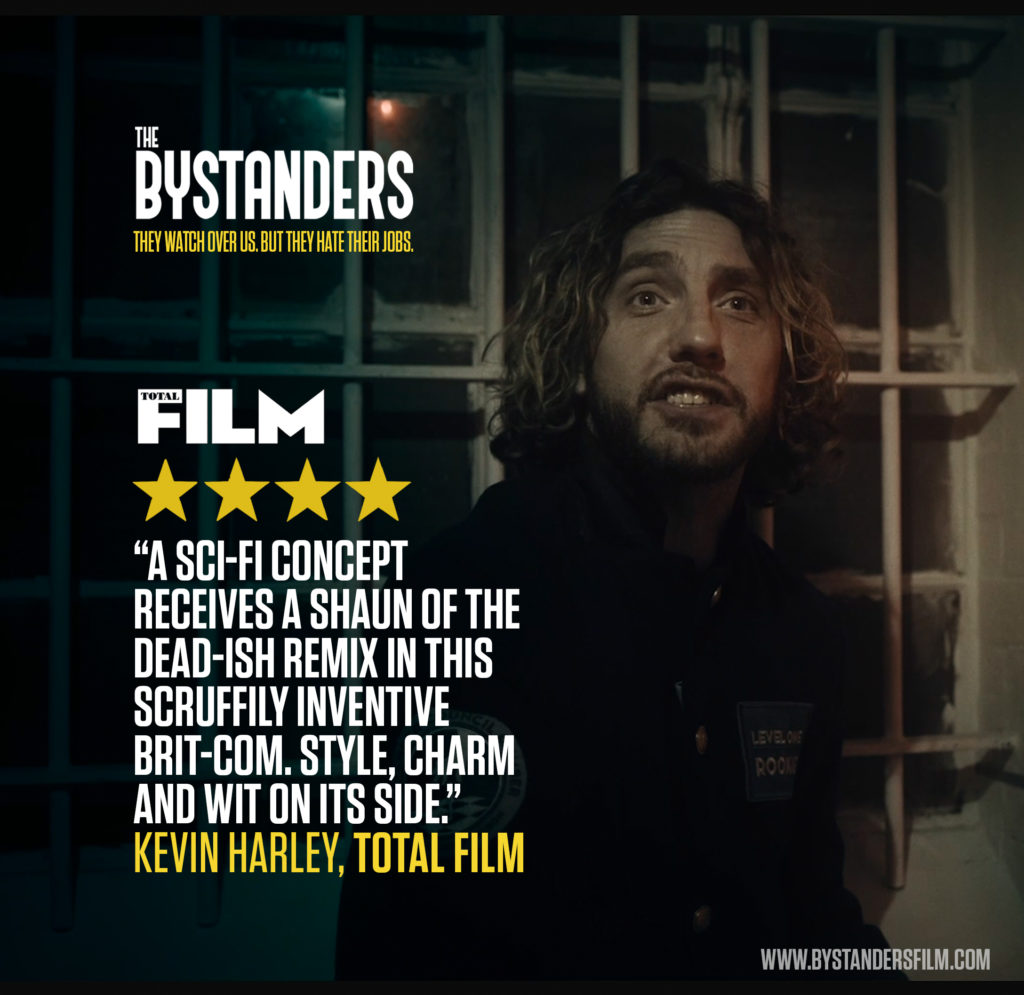This week, I sat down with Brightonian director, Gabriel Foster Prior to talk about the release of his debut feature film, The Bystanders. The film is an off-the-wall comedy set in the world of the Bystanders – invisible immortals who watch over their human subjects and intervene in (or interfere with) their lives.
The film will be showing at The Duke of York Picturehouse on the 18th of October and will be followed by a live Q+A with Director Gabriel Foster Prior, Music Composer and Graphic Designer James ‘Foz’ Foster, VFX Artist Frank Foster and Editor Will Steer. Tickets are still available so book now to experience this funny and heartfelt film.

So, I just finished watching The Bystanders, and it was really funny. I’ll also be seeing it at the screening on the 18th at the Duke of York Picturehouse and I’m looking forward to seeing it on a big screen. I understand that you won a couple of awards; Best Feature at London Sci-Fi Festival, and Best Sci-Fi/Horror Feature at Berlin Independent Film Festival so congratulations on that. I find Sci-Fi to be such an umbrella term. This isn’t a typical Sci-Fi film, so I wonder how would you want to categorise your film?
So, the concept is they’re guardian angel-like creatures. They each look after one human, and they’re recruited from the human world, so they have human fallibilities. They’re lazy and irresponsible, and they get drunk. So that’s the concept but the story is a buddy movie between an enthusiastic newbie and a world-weary veteran (played by Sean Walsh) who hates the subject that he looks after – and generally hates humans because he has to stand and watch them all day and he finds them annoying and boring because all we do all day is look at our phones and stare at computers.
Generally, the bystanders are suffering from that problem but also that now we have mobile phones we can film them when they muck up and cause objects to float around and stuff. So, there is a fantasy element to it, but we regarded it more as a high-concept comedy. The only Sci-Fi element that we considered was that the initial idea originated from the Higgs Boson or ‘God particles’ in the sense that these particles appear, change something, and then disappear again. So, at an early stage, they were human versions of that.
When we started sending it to film festivals, we found that the Sci-Fi film festivals were the most receptive, this is probably due to the score and the visual effects which have Sci-Fi flavours to them.
I find the ‘God particles’ inspiration interesting as those particles contain positive and negative elements and that’s also shown through the two main characters of the film: it feels like you’re showcasing the duality between ambition and apathy in a way. Am I right that one of the messages in the film is a sort of ‘life is what you make of it’ thing?
I agree, I think you got it exactly. In this world, the bystanders are the people who are meant to be looking after us but they’re too busy fighting amongst themselves or just mucking about, so you could take that as a metaphor for whoever is meant to be looking after us or in charge of us in life. So, take authority over your own life because the people who are meant to be running the show are not always super responsible.
I’m sure that resonates with pretty much everyone in the UK at the moment.
Yeah, I think if you’re in the UK that might resonate a bit stronger!
So, one of the main characters, Frank, is the jaded/world-weary one. He’s played by Sean Walsh who grew up in Brighton. Have you guys worked together in the past?
Yeah, we’ve known each other for a long time. We made a web series called ‘The Drunk’ which
you can find on YouTube. We made that ourselves and it’s a silent comedy. Sean loves Charlie
Chaplin, and he’s also very good at playing drunk, I think. So, he wrote this web series where
he’s a drunk guy trying to get home from the pub. We also made a video which played at the
start of one of his tours which we called ‘The Lie-In King’.
We’ve made a few things together and I’ve always thought he’s a really good actor as well as a comedian, so I always had Sean in mind to play the role of Frank. He also helped me to reconnect with people from our web series and he brought on Marek Larwood – he’s someone else that I really, really rate as a comic actor. I think he’s a bit of a genius, so the Role of Norm was written with Marek in mind.
I found that Sean Walsh did a brilliant job at playing the disposition of Frank in a really nuanced, believable way.
He won best actor at the Sydney Sci-Fi Film Festival. What we found funny about that was that
Sir Ben Kingsley was one of the other nominees.
So he got that one over him!
Yeah, that’s the company Sean keeps nowadays!
Did you grow up in Brighton?
Yeah, I moved to Brighton when I was 4 so all my upbringing was in Brighton. I studied film at
Varndean College. There was a media element in my English GCSE, and we had to analyse an
Audi car advert. The teacher was very encouraging of my analysis, and he was someone who
steered me towards film studies at college.
Then I did Art Foundation at what was City College (now MET). The first year is open and my plan was to do graphic design as that was my dad’s profession. But I was making short films with my friends for fun, including one that I did with Jack Hughes (Co-Writer of The Bystanders).
We made a film together called Time Toilet, which I might revisit for a feature. One of the teachers at City College encouraged me to apply to film schools rather than graphic design schools. I’d like to think that she thought “Oh my god, he’s a young film-making genius” but it’s more likely that I lit up more talking about film than graphic design.
Do you get much time to be in Brighton between projects?
I’ve been living in Brighton pretty much since COVID-19, but at the moment I’m living in London for the duration of the project I’m currently editing. So I’m back and forth a lot. If I could stay in Brighton and work in Brighton, I’d be happy. I like London too, but Brighton is where I grew up. I’ve been going to Jubilee Library to write my new feature project, I think that’s a really nice space.
So new project, not Time Toilet related?
No, but the one I’m working on now is possibly more Sci-Fi than The Bystanders. It’s in the early draft at the moment so it might all change, but it’s about conspiracy theories and a guy who thinks there might be a new Bermuda Triangle in Iceland. So, working on new scripts and still doing editing too.
So, with all your experience editing, did you find it difficult writing and directing The
Bystanders, then handing over the editing side to someone else?
The editor is another Brightonian, Will Steer. We’ve worked together before on a lot of different projects. The idea was that we were going to collaborate, and we weren’t sure how much I would get involved at the start. I did do some of the cutting myself, but it was less than I expected in the sense that I was really happy with Will’s work, and I didn’t need to change much because I really liked what he did.
It was his first film as a feature editor, and I think he did a really good job. I think if you’re doing a low-budget film, I would suggest finding people who have lots of experience but haven’t yet been given the opportunity of a lead position. The first feature somebody does will always feel special and people feel really invested in it.
They’re more of a Peter than a Frank you could say.
Yes, that’s right!
In the film, there are two, and arguably three different palettes that are going on where some scenes are in colour, some are in black and white, and then the Rotoscope effects are really vibrant. What was your inspiration for that?
The black & white and colour; one of our inspirations for that is a film Wings of Desire by Wim Wenders. It’s a much more serious arthouse film but Me and Jack both love it. It was kind of an homage because they do black & white for the angel world and then it goes into colour for the human world. We thought it would give The Bystanders something a bit unique, but it was also a tool because it helps to establish a point of view.
When you switch, the audience knows that the perspectives have switched. It helps with the grammar of the storytelling and delivering the jokes. I thought it may be jarring but after a test shoot, we found out that if you balance the contrast between the two shots, the brain adapts very quickly.
The rotoscoping is something Jack and I have enjoyed doing since we were making videos when we were younger, so we wanted to bring that into the movie. We could have tried to do a Marvel-style CGI, but we thought our budget wouldn’t give us the right results. I also really like Michel Gondry who uses this sort of hand-made aesthetic in his films and music videos.
Before we go, I just wanted to congratulate you on the accuracy of the ‘out-of-date training induction video’ for The Bystanders. I thought that was really, really funny.
That was actually shot on VHS cameras that we rented which I think helps. Again, the intro
graphics with the video are something Jack and I did. Also, knowing that we wanted to have
Marek in it – he does these spoof videos which are quite similar. That was another reason to do it because we knew he’d be really funny in them. I’m going to release the full version of ‘How to Be a Bystander’ online soon because I think there’s some gold in there that didn’t quite make it.
I look forward to seeing that! I noticed that the film also uses a lot of close-ups which
reminded me of the absurdism style of Terry Gilliam, are you into his stuff?
I remember doing an essay on him at Varndean. The last film I watched was actually a rewatch
of 12 Monkeys by him, he’s definitely someone I really love. It’s interesting because I didn’t talk about Terry Gilliam with any of the crew specifically but when you’re a fan of someone the influences show through.
I think the one thing that makes it feel Gilliam-esque is the wide-angle lenses on the close-ups in the Bystander world. It gives it all another dimension, and everything is exaggerated through an 18 or 14-mm lens. We even used a 10mm lens in a scene which is practically a fisheye. The thing about wide-angle lenses for a close-up is you have to get the camera right up in the actors’ faces. Luckily the actors were all good sports.
Thanks, Gabriel, for speaking with me. It’s been an absolute pleasure talking to you. I look forward to seeing The Bystanders next week on the big screen.
Thanks man, I appreciate it.
To find out more and book tickets to the screening: https://www.picturehouses.com/movie-the-bystanders-q-a

